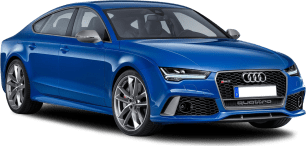A race circuit is the best place to test the performance of an Audi R8. I've been lucky enough to have done this in the past, but for this update of the R8 the Australian launch was held on public roads and included a convoy of RS models such as the RS 6 Avant, RS 7, RS Q3 and TT RS.
Even then I think I was 'stitched up' because I began the day in the R8 V10 Performance Coupe but spent almost the entirety of my allocated time in roadworks at 40km/h before swapping to an RS Q3.
So, while I can't honesty comment about the dynamics on this updated R8 V10 Performance Coupe I can tell you that having driven every iteration of the R8 since 2012 that it's a weapon, with helicopter-like visibility out of that large front window.
If, like me, you think turbos are 'cheating' (superchargers are fine), then you'll love the linear power delivery of the R8's naturally aspirated V10, and while I love front-engined sportscars, nothing beats a mid-engined car for the feeling of balance and lightness in the nose while having the sound of thousands of explosions going off just behind your back.
Having AWD is not just great for acceleration and perfect traction from Audi's quattro system, I think it's a good safety feature in a supercar, and while only your judgements can stop things going pear shaped, the system will be there to help on slippery roads.
The following day was different. I was in the R8 V10 RWD, the country roads were superb and while it wasn't a racetrack it was enough to get a hint of the capabilities of the RWD R8.
While the R8 V10 RWD feels the same to sit in with the same great view, it feels different to drive than its faster sibling, in a good way. First there's the noticeable power difference – more than 50kW and 20Nm less – but also the lack of AWD makes the front end feel more pointable, and the car feel more like a traditional sportscar that pushes from behind rather than pulling from the front. Less power, but more fun.
The RS cars in our test convoy were all awesome machines, but stepping out of even the RS6 Avant and slipping down into the R8 cockpit was like getting into a UFO – it's so far ahead dynamically of any other Audi that all I could do was laugh like an idiot. Corners which were making an RS 7 really struggle, were handled effortlessly by the R8. And in a straight line it's a bullet in a barrel.
The Performance has the better brakes: 380mm ceramic discs with six piston calipers up front and 356mm discs with four piston calipers at the rear. The RWD has steel discs – 365mm with eight piston calipers up front and 356mm discs with four piston calipers in the rear.
Keep in mind if you are planning on track days, you'll find the ceramic discs costly to replace, and beside the stopping power of the steel ones is excellent.
And yet, on pot holed course bitumen the ride is a lot more comfortable than you might think and having driven the Performance in traffic it's a much nicer place to sit than the claustrophobic cabin of a McLaren 570S. You could honestly use the R8 daily.

